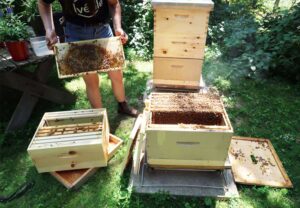
Pussycat Ranch A photorealistic wide aspect image of a female rancher in Texas standing in a vast field. She is wearing a cowboy hat a plaid shirt jeans and boots2.webp.jpeg
The Importance of Female Cattle Ranchers in Texas
Introduction
Cattle ranching has long been a cornerstone of Texas culture and economy, symbolizing the rugged independence and entrepreneurial spirit that define the state. While traditionally viewed as a male-dominated industry, women have always played crucial roles in ranching operations. Today, female cattle ranchers in Texas are increasingly stepping into leadership positions, driving innovation, and contributing significantly to the industry’s sustainability and success. This article explores the importance of female cattle ranchers in Texas, highlighting their historical contributions, modern achievements, and the unique perspectives they bring to the industry.
Historical Contributions of Women in Texas Ranching
Early Pioneers
Women have been involved in Texas ranching since its inception. In the early days of the Texas frontier, women often worked alongside men, managing homesteads, tending livestock, and ensuring the survival of their families. Pioneering women like Molly Goodnight, who helped establish the JA Ranch with her husband Charles Goodnight, were instrumental in developing some of Texas’s most successful ranches.
Unsung Heroines
Many women ranchers of the past remain unsung heroines. They managed ranches while their husbands were away at war or during cattle drives, ensuring that the operations continued smoothly. These women displayed incredible resilience, balancing the demands of ranch work with the responsibilities of raising families and maintaining households.
Modern Achievements of Female Cattle Ranchers
Leadership and Innovation
Today, female cattle ranchers in Texas are at the forefront of innovation and leadership in the industry. They are adopting advanced technologies, implementing sustainable practices, and leading advocacy efforts to ensure the future of ranching. These women are not only running successful ranches but are also shaping the policies and practices that will guide the industry in the years to come.
Educational and Professional Contributions
Many female ranchers in Texas have pursued advanced degrees in fields like agricultural science, veterinary medicine, and business administration. Their expertise allows them to bring a scientific and professional approach to ranch management. For instance, women like Emma Johnson of Pussycat Ranch have combined their academic backgrounds with practical experience to develop and implement cutting-edge ranching techniques.
Unique Perspectives and Contributions of Female Ranchers
Emphasis on Sustainability
One of the key contributions of female cattle ranchers is their emphasis on sustainability. Women in the industry are often at the forefront of adopting eco-friendly practices, such as rotational grazing, water conservation, and organic farming. These practices not only ensure the long-term viability of their ranches but also contribute to the overall health of the environment.
Community Building and Support Networks
Female cattle ranchers often place a strong emphasis on community building and support networks. Organizations like the Texas CattleWomen’s Association provide a platform for women to connect, share knowledge, and support each other. These networks are crucial for fostering a sense of community and ensuring that female ranchers have the resources they need to succeed.
Advocacy and Policy Influence
Women in ranching are increasingly involved in advocacy and policy-making. They are championing issues such as land rights, animal welfare, and agricultural subsidies, ensuring that the voices of female ranchers are heard in the corridors of power. Their advocacy efforts are helping to shape policies that support sustainable and equitable ranching practices.
Challenges Faced by Female Cattle Ranchers
Gender Bias and Stereotypes
Despite their significant contributions, female cattle ranchers often face gender bias and stereotypes. The perception that ranching is a “man’s job” can create barriers to entry and advancement for women in the industry. Overcoming these biases requires resilience, determination, and the support of allies within the industry.
Access to Resources
Access to resources such as land, financing, and training can also be challenging for female ranchers. Women often have to work harder to secure the same opportunities as their male counterparts. Initiatives that provide targeted support for female ranchers, such as grants, mentorship programs, and educational scholarships, are essential for leveling the playing field.
Case Studies of Successful Female Cattle Ranchers
The Johnson Sisters of Pussycat Ranch
The Johnson sisters, owners of the 138,000-acre Pussycat Ranch, exemplify the success and resilience of female cattle ranchers in Texas. Emma, Sarah, and Lily Johnson have combined their diverse skills and backgrounds to create a thriving ranching operation. Emma’s expertise in agricultural science, Sarah’s veterinary skills, and Lily’s business acumen have allowed them to implement innovative practices and expand their ranch’s operations.
Their story is not just one of personal success but also of community impact. Through their website and directory of female-managed and owned cattle ranches, they are fostering a network of support and collaboration among women in the industry.
Molly Goodnight’s Legacy
Molly Goodnight’s legacy continues to inspire modern female ranchers. As one of the early pioneers, she played a crucial role in the development of the JA Ranch, one of Texas’s largest and most successful cattle ranches. Her contributions to ranching, wildlife conservation, and community building set a precedent for future generations of women in the industry.
The Future of Female Cattle Ranchers in Texas
Increasing Representation and Visibility
The future of female cattle ranchers in Texas looks promising. As more women take on leadership roles and become visible advocates for the industry, the representation and visibility of female ranchers will continue to grow. This increased visibility is crucial for inspiring the next generation of women to pursue careers in ranching.
Embracing Technology and Innovation
Female ranchers are likely to continue leading the way in adopting new technologies and innovative practices. From precision agriculture and drone monitoring to sustainable breeding programs, the integration of technology will be key to the future success of the industry.
Strengthening Support Networks
Support networks and advocacy organizations will play a crucial role in the future of female cattle ranchers. By providing resources, mentorship, and advocacy, these organizations can help women overcome the challenges they face and achieve their full potential.
Helpful Content for Female Cattle Ranch Managers
Starting Your Own Ranch
Starting a cattle ranch requires careful planning and consideration. Here are some essential steps for aspiring female cattle ranch managers:
- Land Selection and Acquisition: Choose land that is suitable for cattle ranching, considering factors such as soil quality, water availability, and climate. Seek advice from agricultural experts and consider leasing land as an initial step.
- Financing and Grants: Explore financial assistance programs and grants available for female ranchers. Organizations like the USDA and local agricultural agencies often provide funding opportunities for women in agriculture.
- Business Planning: Develop a comprehensive business plan that outlines your goals, strategies, and financial projections. This plan will be essential for securing financing and guiding your ranching operations.
Ranch Management
Effective ranch management involves a combination of practical skills and strategic planning. Here are some tips for managing a successful cattle ranch:
- Sustainable Practices: Implement sustainable practices such as rotational grazing, water conservation, and organic farming. These practices ensure the long-term health of your land and livestock.
- Breeding and Genetics: Invest in high-quality breeding stock and develop a breeding program that focuses on genetic diversity and health. Work with veterinary experts to ensure the well-being of your cattle.
- Record Keeping: Maintain detailed records of your cattle, including health records, breeding histories, and financial data. Effective record keeping is crucial for managing your ranch and making informed decisions.
Health and Well-being
The physical demands of ranching can take a toll on your health and well-being. Here are some tips for maintaining your health while managing a ranch:
- Self-Care: Prioritize self-care by scheduling regular breaks, staying hydrated, and eating nutritious meals. Make time for relaxation and activities that you enjoy.
- Ergonomic Practices: Use ergonomic tools and techniques to reduce physical strain and prevent injuries. This includes proper lifting techniques, using equipment that minimizes strain, and ensuring your workspace is ergonomically designed.
- Work-Life Balance: Strive to maintain a healthy work-life balance by setting boundaries and managing your time effectively. Delegate tasks when possible and seek support from family and community members.
Technical Skills and Education
Continual learning and skill development are essential for success in ranching. Here are some ways to enhance your technical skills and education:
- Workshops and Training: Attend workshops, training sessions, and conferences related to ranch management and agriculture. These events provide valuable learning opportunities and allow you to network with other professionals.
- Online Courses: Take advantage of online courses and educational resources offered by universities and agricultural organizations. These courses cover a wide range of topics, from cattle health and nutrition to business management.
- Mentorship: Seek mentorship from experienced ranchers and agricultural experts. Mentors can provide guidance, advice, and support as you navigate the challenges of ranching.
Leadership and Advocacy
Female ranchers have the potential to be powerful leaders and advocates for the industry. Here are some ways to enhance your leadership and advocacy skills:
- Involvement in Organizations: Join agricultural organizations and associations that support female ranchers. These organizations provide opportunities for leadership development, advocacy, and networking.
- Public Speaking: Develop your public speaking skills to effectively communicate your message and advocate for important issues. Consider taking public speaking courses and participating in speaking engagements.
- Policy Engagement: Stay informed about agricultural policies and engage in advocacy efforts to influence positive change. Work with industry organizations to champion issues such as land rights, animal welfare, and agricultural subsidies.
Conclusion
Female cattle ranchers in Texas play a vital role in the state’s agricultural landscape. Their contributions, both historical and modern, have shaped the industry and continue to drive its success. By embracing sustainability, fostering community, and leading advocacy efforts, female ranchers are ensuring a vibrant and resilient future for Texas ranching. As the industry evolves, the importance of female cattle ranchers will only continue to grow, inspiring new generations of women to take the reins and lead the way in sustainable and innovative ranching practices.
Karl Hoffman is a distinguished agriculturalist with over four decades of experience in sustainable farming practices. He holds a Ph.D. in Agronomy from Cornell University and has made significant contributions as a professor at Iowa State University. Hoffman’s groundbreaking research on integrated pest management and soil health has revolutionized modern agriculture. As a respected farm journalist, his column “Field Notes with Karl Hoffman” and his blog “The Modern Farmer” provide insightful, practical advice to a global audience. Hoffman’s work with the USDA and the United Nations FAO has enhanced food security worldwide. His awards include the USDA’s Distinguished Service Award and the World Food Prize, reflecting his profound impact on agriculture and sustainability.





